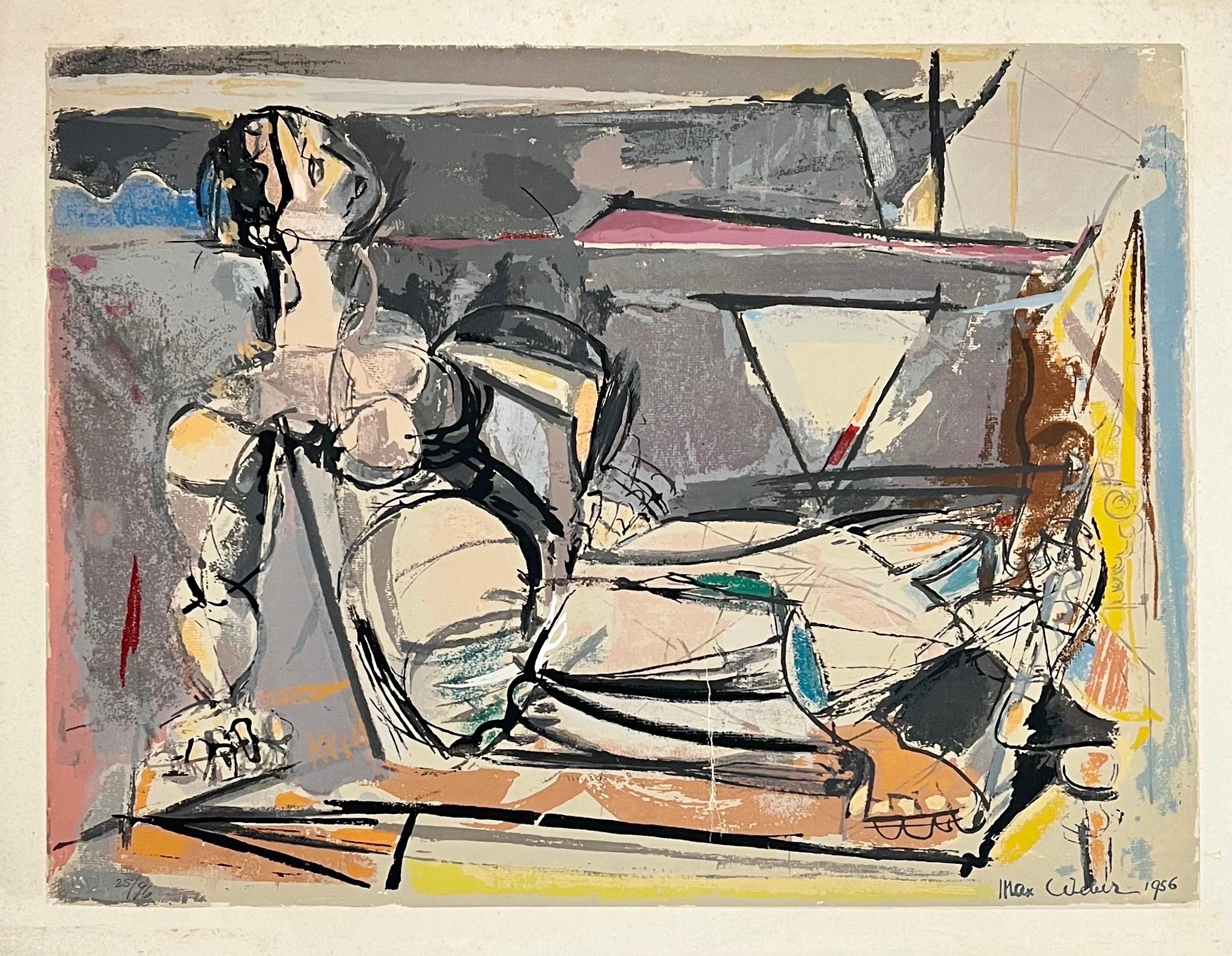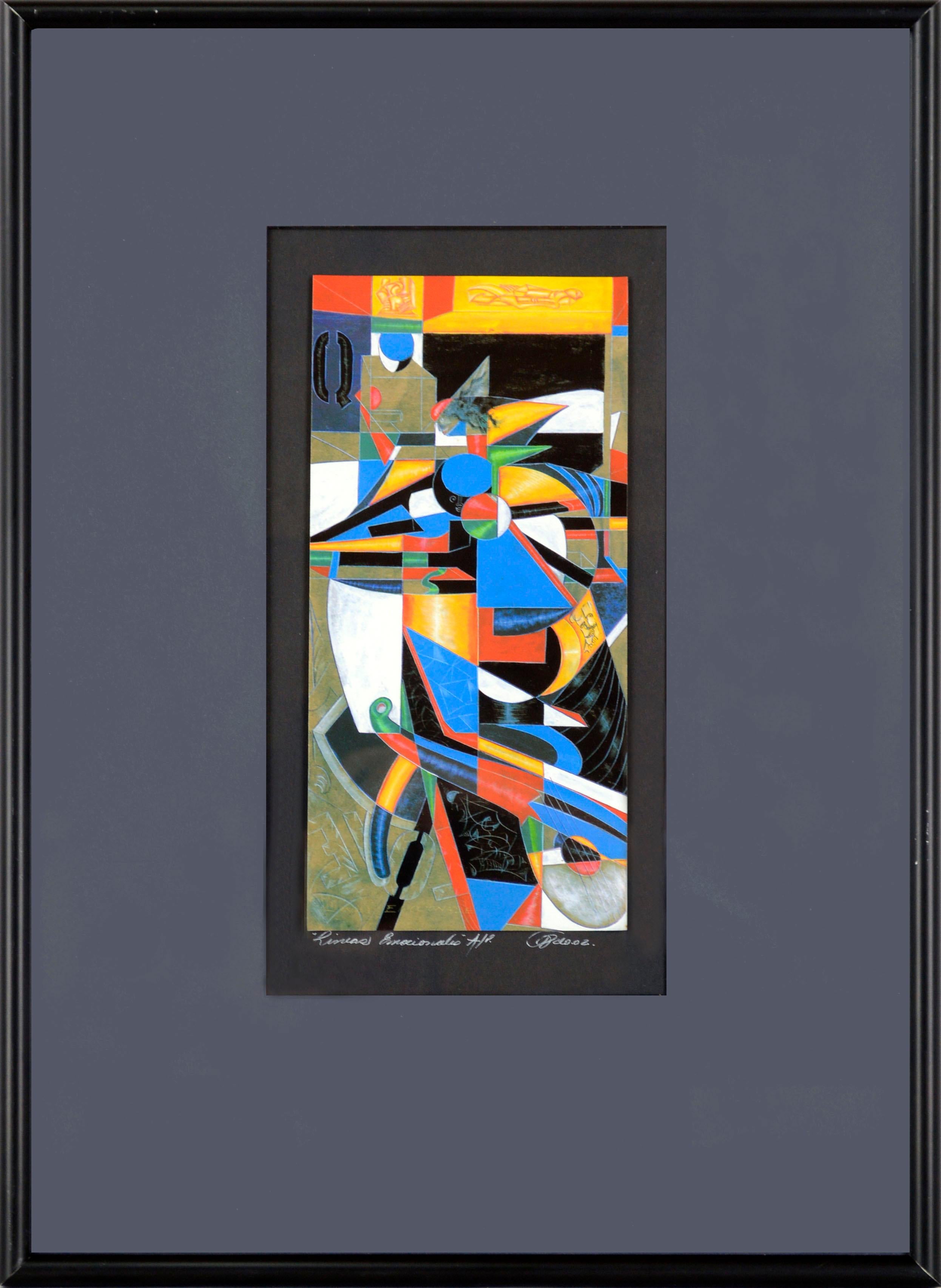Items Similar to Eye of the Peacock, Cubist Abstract Silkscreen by David Porter
Want more images or videos?
Request additional images or videos from the seller
1 of 7
Edwin David PorterEye of the Peacock, Cubist Abstract Silkscreen by David Porter1971
1971
About the Item
Artist: David Porter, American (1912 - 2005)
Title: Eye of the Peacock
Year: 1971
Medium: Silkscreen on Canvas mounted to paper, signed, dated, and numbered in pencil
Edition: 193/250
Image Size: 39 x 32 inches
Paper Size: 42 x 34 inches
- Creator:Edwin David Porter (1912 - 2005, American)
- Creation Year:1971
- Dimensions:Height: 42 in (106.68 cm)Width: 34 in (86.36 cm)Depth: 0.1 in (2.54 mm)
- Medium:
- Movement & Style:
- Period:
- Framing:Framing Options Available
- Condition:
- Gallery Location:Long Island City, NY
- Reference Number:1stDibs: LU4663973512
About the Seller
4.8
Gold Seller
These expertly vetted sellers are highly rated and consistently exceed customer expectations.
Established in 1979
1stDibs seller since 2014
2,720 sales on 1stDibs
Typical response time: <1 hour
- ShippingRetrieving quote...Ships From: Long Island City, NY
- Return PolicyA return for this item may be initiated within 7 days of delivery.
More From This SellerView All
- Cubist Composition, Lithograph by Jean HelionBy Jean HélionLocated in Long Island City, NYJean Hélion was a French painter (1904 - 1987) whose abstract work of the 1930's established him as a leading modernist. His mid-career rejection of abstraction was followed by nearl...Category
1930s Cubist Abstract Prints
MaterialsLithograph
- Homme a la Pipe Assise sur un TabouretBy Pablo PicassoLocated in Long Island City, NYShowcasing a figure seated on a stool against an emerald green background, Pablo Picasso's print demonstrates the development and versatility of Cubism. Seen from multiple angles sim...Category
Late 20th Century Cubist Abstract Prints
MaterialsLithograph
- Homme Au CornetBy Pablo PicassoLocated in Long Island City, NYSurrounded by a charcoal background, the male figure at the center of this Pablo Picasso print appears illuminated by the light emanating from the upper right corner. Infused with a ...Category
Late 20th Century Cubist Abstract Prints
MaterialsLithograph
- Carnaval, Cubist Linocut by Pablo PicassoBy Pablo PicassoLocated in Long Island City, NYIt is the night before Lent, the season when Catholics fast and abstain from pleasure in order to bring themselves closer to God. But it is Fat Tuesday, ...Category
1960s Cubist Abstract Prints
MaterialsLinocut
- Femme au corset tesant un livreBy Pablo PicassoLocated in Long Island City, NYReading a book, the woman wearing a corset in this Pablo Picasso print is rendered in an angular, fragmented fashion emblematic of the artist's Cubist style. While the artist has ren...Category
Late 20th Century Cubist Abstract Prints
MaterialsLithograph
- Femme Profile (Marie-Therese Walter)By Pablo PicassoLocated in Long Island City, NYRendered in profile, Marie-Therese Walter is shown wearing a purple beret and a brown coat with fluffy trim. One of Pablo Picasso's famed muses, this representation of her is reminis...Category
Late 20th Century Cubist Abstract Prints
MaterialsLithograph
You May Also Like
- American Modernist Cubist Lithograph Screenprint "Reclining Woman" Max WeberBy Max WeberLocated in Surfside, FLReclining Cubist Nude Woman Max Weber (April 18, 1881 – October 4, 1961) was a Jewish-American painter and one of the first American Cubist painters who, in later life, turned to more figurative Jewish themes in his art. He is best known today for Chinese Restaurant (1915), in the collection of the Whitney Museum of American Art, "the finest canvas of his Cubist phase," in the words of art historian Avis Berman. Born in the Polish city of Białystok, then part of the Russian Empire, Weber emigrated to the United States and settled in Brooklyn with his Orthodox Jewish parents at the age of ten. He studied art at the Pratt Institute in Brooklyn under Arthur Wesley Dow. Dow was a fortunate early influence on Weber as he was an "enlightened and vital teacher" in a time of conservative art instruction, a man who was interested in new approaches to creating art. Dow had met Paul Gauguin in Pont-Aven, was a devoted student of Japanese art, and defended the advanced modernist painting and sculpture he saw at the Armory Show in New York in 1913. In 1905, after teaching in Virginia and Minnesota, Weber had saved enough money to travel to Europe, where he studied at the Académie Julian in Paris and acquainted himself with the work of such modernists as Henri Rousseau (who became a good friend), Henri Matisse, Pablo Picasso, and other members of the School of Paris. His friends among fellow Americans included some equally adventurous young painters, such as Abraham Walkowitz, H. Lyman Sayen, and Patrick Henry Bruce. Avant-garde France in the years immediately before World War I was fertile and welcoming territory for Weber, then in his early twenties. He arrived in Paris in time to see a major Cézanne exhibition, meet the poet Guillaume Apollinaire, frequent Gertrude Stein's salon, and enroll in classes in Matisse's private "Academie." Rousseau gave him some of his works; others, Weber purchased. He was responsible for Rousseau's first exhibition in the United States. In 1909 he returned to New York and helped to introduce Cubism to America. He is now considered one of the most significant early American Cubists, but the reception his work received in New York at the time was profoundly discouraging. Critical response to his paintings in a 1911 show at the 291 gallery, run by Alfred Stieglitz, was an occasion for "one of the most merciless critical whippings that any artist has received in America." The reviews were "of an almost hysterical violence." He was attacked for his "brutal, vulgar, and unnecessary art license." Even a critic who usually tried to be sympathetic to new art, James Gibbons Huneker, protested that the artist's clever technique had left viewers with no real picture and made use of the adage, "The operation was successful, but the patient died."[8] As art historian Sam Hunter wrote, "Weber's wistful, tentative Cubism provided the philistine press with their first solid target prior to the Armory Show." The Cellist...Category
Mid-20th Century Cubist Abstract Prints
MaterialsScreen
- Modern Cubist Abstract in Primary Colors, A/P by Juan QuevedoLocated in Soquel, CAModern Cubist Abstract in Primary Colors, A/P by Juan Quevedo "Linias Emocionales", a bold and bright cubist abstract artist proof screen print by Juan...Category
Early 2000s Cubist Abstract Prints
MaterialsPaper, Screen
- Figural Abstract Mid Century Modern Lithograph Portraits, Judaica, Jewish PrintBy Rita GombinskiLocated in Surfside, FLThis is a proof print and is unsigned. it has Jewish Hebraic motifs, a menorah with a Jewish star, a mezusah or megilla scroll by this talented Jewish woman artist. Her whole life lo...Category
Mid-20th Century Cubist Figurative Prints
MaterialsCanvas, Oil
- Cin Cin - Etching by G. I Brook - 20th CenturyLocated in Roma, ITCin Cin is an original etching artwork realized by G. I Brook, Signed on the plate. In very good condition. Included a White Passepartout: 49 x 34 cm. The a...Category
20th Century Cubist Abstract Prints
MaterialsEtching
- Liberté j'écris ton nom, by Paul EluardBy Fernand LégerLocated in Wilton, CTComposition in colors by Fernand Léger on the famous poem by his friend Paul Éluard, published clandestinely in Poésie et vérité during the Occupation in 1942. This illustration was ...Category
1950s Cubist Abstract Prints
MaterialsLithograph
- Les Deux AngesBy Marie LaurencinLocated in New York, NYA very good impression of this lithograph with strong colors. Second state (of 2). Signed and numbered 19/160 in pencil, lower left.Category
1940s Cubist Abstract Prints
MaterialsColor, Lithograph





